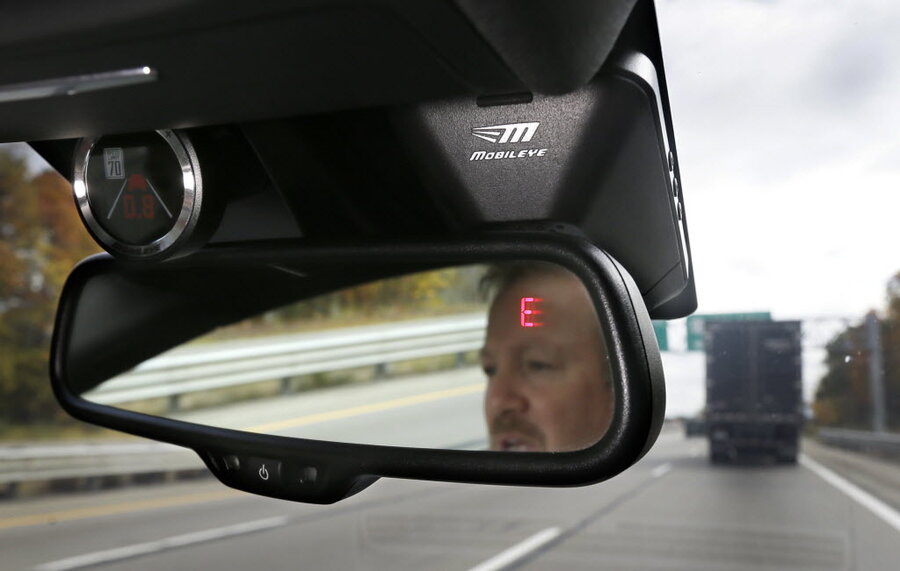Why baby boomers embrace sensor-driven cars, but doubt self-driving cars
Loading...
Baby boomer-aged drivers increasingly support new sensor-driven improvements in cars that aim to ease some aspects of driving, such as warning systems that alert a driver of a blind spot, help them change lanes, and ease parallel parking with backup cameras, a new study has found.
Nearly all – 96 percent – of the participants in the study of drivers aged 50 to 69 said they would support at least one of seven sensor-driven vehicle technologies currently making their way to car models, according to the study, conducted by researchers from insurance company The Hartford and the Massachusetts Institute of Technology’s Age Lab.
Systems that can predict an imminent collision and “smart” headlights that react to road conditions to avoid blinding other drivers also received widespread support, with 67 percent of the study’s participants saying they would be willing to use four of the seven technologies if they were available.
The insurer has been studying safe driving for older drivers for several years at its Center for Mature Market Excellence.
“In this current study, we really wanted to take it further and find out about the issue of adoption,” says Jodi Olshevski, a gerontologist at The Hartford who directs the center. "It’s one thing to know what the technologies are; it’s another to discover if drivers are going to use them."
“The good news story is that we know older drivers are interested in this technology and willing to learn more about it,” she adds.
To conduct the study, the researchers showed videos of seven vehicle technologies to 302 participants and their measured their perceptions of each tool, such as systems that assist with parking and adaptive cruise control, which automatically adjusts the speed a car is traveling if it nears another car on the highway .
As the race to create fully autonomous cars heats up, the study would seem to bolster claims by Google and other technology companies that self-driving cars could provide a better transportation option for older people who may have cut back or stopped driving for health reasons.
The researchers also examined self-driving cars, showing a video of the technology to participants. But, they found, some drivers were skeptical about the potential of fully autonomous cars, mirroring similar concerns about partially automated systems such as parking assistance and the adaptive cruise control technology.
“I think they were concerned that you could become too reliant on them,” Ms. Olshevski says. “It’s almost like a rite of passage that you learn to parallel park, and I think the idea that you don’t learn those skills, and you don’t use those skills, they were a little worried about that, particularly in urban areas.”
While 70 percent said they would consider test-driving a self-driving car, only 31 percent said they would consider purchasing one, even if it was the same price as a regular car. There was also a gender divide, with men more likely than women to both test-drive and purchase a self-driving car.
Features aimed mostly at improving safety – such as back-up cameras, blind spot warning systems, and smart headlights – received more praise overall.
The Hartford’s study also showed some differences among older consumers who were likely to adopt a car that included some technologically-advanced features, with people who identified themselves as tech-savvy saying they were more likely to embrace the new technologies.
That’s a problem other technology companies have sometimes faced, with a participant at Microsoft’s annual shareholder meeting in December questioning company head Satya Nadella about charges of ageism in its marketing campaigns.
“I see a lot of grey hairs here, but not many in your commercials,” the man said. “Are you dealing with this, besides sexism and racism? Are there any [Xbox] games for people 50-plus?”
The study, released in conjunction with Older Driver Safety Awareness Week, which focuses on providing drivers with safety tips and education materials, chose to focus on 50 to 69-year-old drivers in order to examine how the country’s large boomer population stays on the road as they age.
New technology is “really an important part of the conversation, because it’s always beneficial to enhance driving safety,” Olshevski says. “It’s not just going to the doctor’s office, it’s going to get an ice cream cone on a hot summer’s evening and being able to get out of the house and get around.”
“I think it will be a process of helping older drivers realize that these systems can be helpful, but they can’t replace these safe driving skills,” she adds.





